TAPAS.network | 31 July 2023 | Reviews and Reflections | Phil Goodwin
50th Anniversary of the Transport Studies Unit, Oxford University: A Memoir

was a Visiting Fellow at TSU in 1976, after a degree in economics, a PhD in civil engineering, and 5 years on policy appraisal at the Greater London Council. He was appointed Assistant Director in 1979, then Director and Reader in Transport Studies, and Professorial Fellow at Linacre College, until the end of 1995, when he and TSU decamped to continue its research programme at UCL until 2004. He reflects on TSU’s 50th Anniversary.
The Arc of TSU
Having been (up to now) TSU’s longest serving Director, I was pleased to open the 50th Anniversary celebrations, with an assessment of its changing role over the years.
The arc of TSU has been an unusual one. The pre-history in the 1950s was intended as a focus for the intellectual activity of the transport industries. The Unit itself started in 1973, with Ian Heggie as Director, as a mostly detached part of the Economics Sub-Faculty, with almost no teaching, entirely self-funding, and research that was a challenge to the prevailing transport orthodoxy of economics-based modelling. When I was Director, it developed a strong research-based influence on policy, mostly in challenging the predominance of ‘predict and provide’ approaches subordinated to car dependence. At the height of this influence, in 1994, we were awarded an exceptional ESRC ‘centre of excellence’ designation, with 10 year funding based on rethinking traffic growth and replacing equilibrium methodologies by dynamic ones: that work was completed not in Oxford, but by the Unit decamping to London. In Oxford a new TSU was created in 1996, moved from Economics to the School of Geography, directed successively by John Preston (1997-2005), David Banister (2006-2015) and Tim Schwanen (2015 to date), with a shared mission to become academically fully integrated within Geography (the only major transport research group so placed), a full teaching programme at Bachelors, Masters and Doctoral level, increasingly international membership, and building up a research emphasis on the environment, sustainability, equity and social concerns.
There is surely no question that TSU’s current position is more secure, and more integrated within the University, than it was in my day.
Within this broad arc, I’d like to focus on some thoughts about the early days, and the most recent period.
The Early Days
The TSU backstory started in 1958, with an endowment given to Oxford University by the Chartered Institute of Transport. CIT (now CILT, to include logistics) was never an academic institution. It is the professional institute of the transport industry, mainly professionals working in bus, train and haulage companies, and with roots in military transport and logistics. Its intention in setting up the endowment was to promote the study of transport as a respectable academic subject, so that Universities would contain people who were knowledgeable – and supportive – of the transport industry.
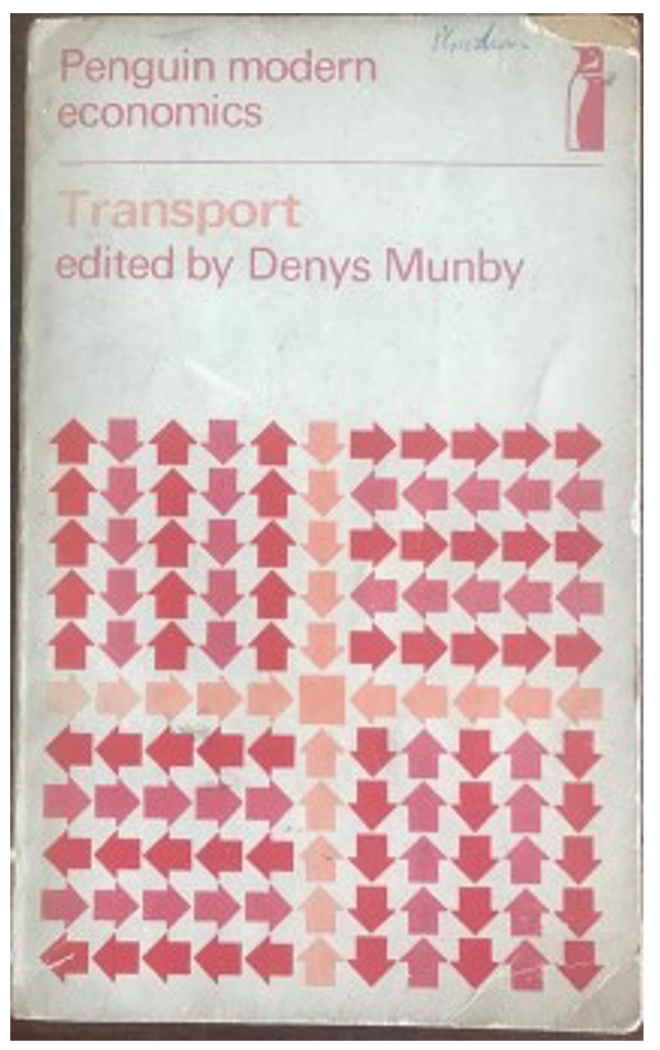
Denys Munby, of Nuffield College, was appointed as Reader in the Economics and Organisation of Transport, who I remember mainly for two pieces of work. The first was an encyclopedic compilation of statistics of the bus industry from 1900 to 1950, an astonishingly detailed work of scholarship, but long forgotten. He also edited the first compilation of readings in transport economics, published by Penguin[1] , no less, as part of a series on new economic thought. My generation knew this book well; though out of print, it is still available. It articulated a new territory, including road pricing, traffic in towns, and transport project appraisal including social cost benefit analysis – a large part of the subsequent research and policy agenda.
There was money left over in the CIT endowment, and it was used to set up the Transport Studies Unit. The first Director was Ian Heggie, who recruited a small group of its first staff. Their research had little overlap with that of Munby, being critical of economic approaches to behaviour, and using the slogan of ‘Putting Behaviour into Behavioural Models’ challenging the presumption that the equations for forecasting travel choices were based on an adequate theory of behaviour. The first major ESRC grant slowly produced a book, ‘Understanding Travel Behaviour’[2], based on an integration of social psychology and human geography, especially the space-time geography of the Swedish geographer Hagerstrand. This sought to replace the dominant paradigm of travel demand as driven by economic choice influenced by times and costs, and emphasised the constraints on that choice especially by family circumstances within a spatial environment.
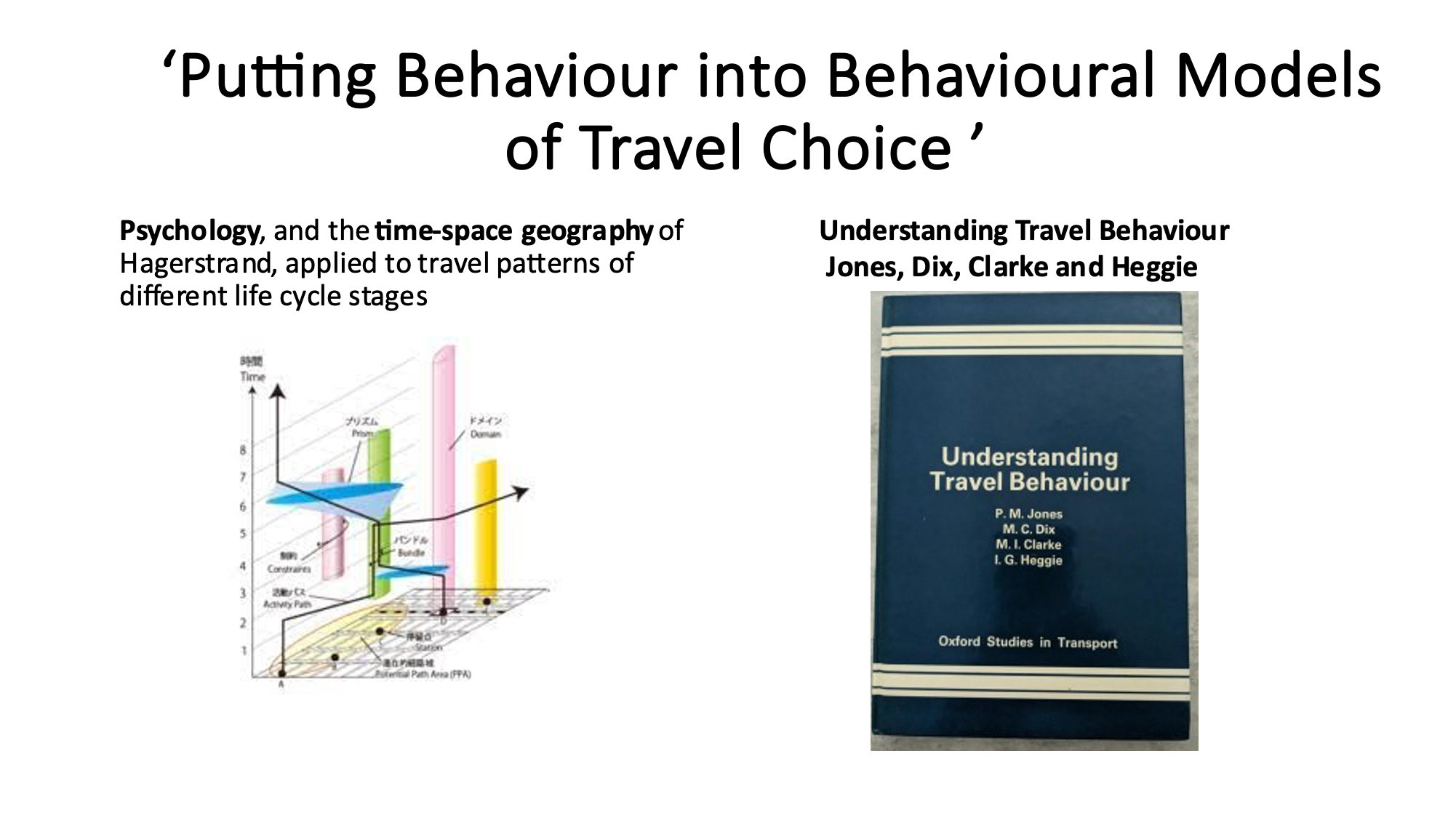
Apart from the CIT endowment, we were completely dependent on the research funds we sought from research councils , charities, and in competitive tenders to the public and private sector. Projects included a study of night bus use in London, the value of travel time for the Department for Transport, Car Dependence for the RAC Foundation, relationships between motorists and the police for the newly formed Police Foundation, (which had Prince Charles as its Patron, and our report was launched by him, well, mentioned in a couple of sentences, at one of his early public speeches). Research Council projects included ‘Travel choice considered as a process‘, with an emphasis on dynamic rather than equilibrium analyses, and ‘The real effects of environmentally-friendly transport policies’, assisted by Carmen Hass-Klau, raising the question of unintended effects, and unexpected effects, both good and bad. Two early DPhil theses were by Graham Parkhurst and Sally Cairns. We also developed an interest in panel surveys, as the source of insight into behavioural dynamics which could not be pursued with the dominant use of cross section equilibrium data.
A large proportion of TSU research involved panels[3]. This also naturally evolved into an interest, especially later, in the formal development of modelling techniques which could handle asymmetric relations, non-reversible responses, and path-dependent processes, especially in the work of Joyce Dargay and her collaborators, as part of the ESRC Centre listed below.
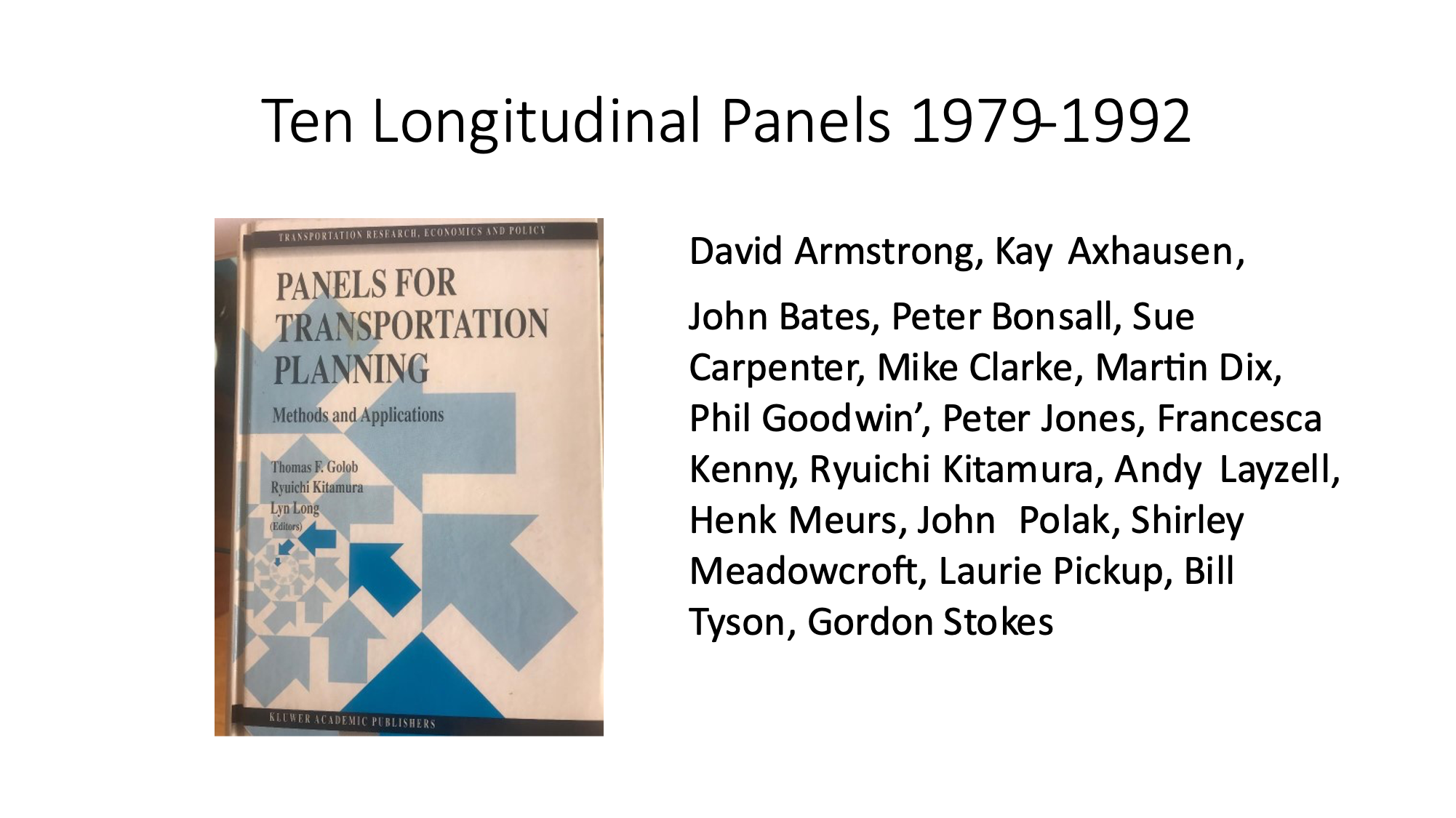
All of this work had policy implications, directly or indirectly. But there were also big policy developments in the transport sector and Government, with an important turning point in about 1989.
This was when Margaret Thatcher’s Government announced a substantially increased road traffic forecasts, and a massive road building programme nominally to cope with it. It was described as ‘the biggest road programme since the Romans’ and grew out of a huge body of official work spanning nearly 90 years, which had created a very substantial intellectual structure of transport analysis and planning, a juggernaut which is mostly misunderstood in academic discourse, because it has been mostly created outside the Universities and published overwhelmingly in what is wrongly called the ‘grey literature’. I’ve written more on this in a recent Tapas column[4], with an argument that the history of the intellectual structure of planning and transport cannot be understood, or changed, without understanding this history.
A research charity, the Rees Jeffreys Road Fund, announced funding for new research on ‘Transport and Society’ which required, we proposed, a fundamental rethink in the orthodoxy of ‘predict and provide’, as the core of road planning. There was competitive bidding from the main University research transport groups, which by then included us. We won the competition.
The work ran from 1989 to 1991, and included a series of commissioned discussion papers around seminars and workshops involving a high proportion of the leading academics and professional institutions, and reflected – or constructed – a growing research and policy consensus which we called the ‘New Realism’[5], based on a new narrative of how to interpret ‘predict and provide’.
A New Narrative
Predict and Provide – for all its elaborate models and appraisals – essentially relied on the idea that traffic would inevitably increase in line with income, and therefore additional road capacity was essential to provide for it. But the 1989 traffic forecasts implied a volume of traffic increasing more than the road capacity could be increased. If traffic increases more than capacity, congestion will increase.
Therefore the predict and provide approach did not mean ‘congestion will improve’ – always the promise for specific schemes – but ‘congestion will get worse, more slowly’.
Therefore demand management (whether by pricing, reallocation of road capacity, planning, investment in alternatives, enforcement or promotion) would be forced to centre stage of transport policy, for reasons of efficiency and quality, quite apart from the environmental and safety case for doing so.
This was the turning point, led politically by Conservative councils in the Southeast, faced with how to deal with additional traffic pouring off the motorways onto local streets that could not be expanded to cope with it, allied to a wider change in climate of opinion in particular that road schemes locally were not being greeted by enthusiasm for their modernism, but problems to the local and wider environment, demonstrations, and protests. It was very high profile work, with very active dissemination marked by an unusually large number of discussions and conferences and invited presentations.
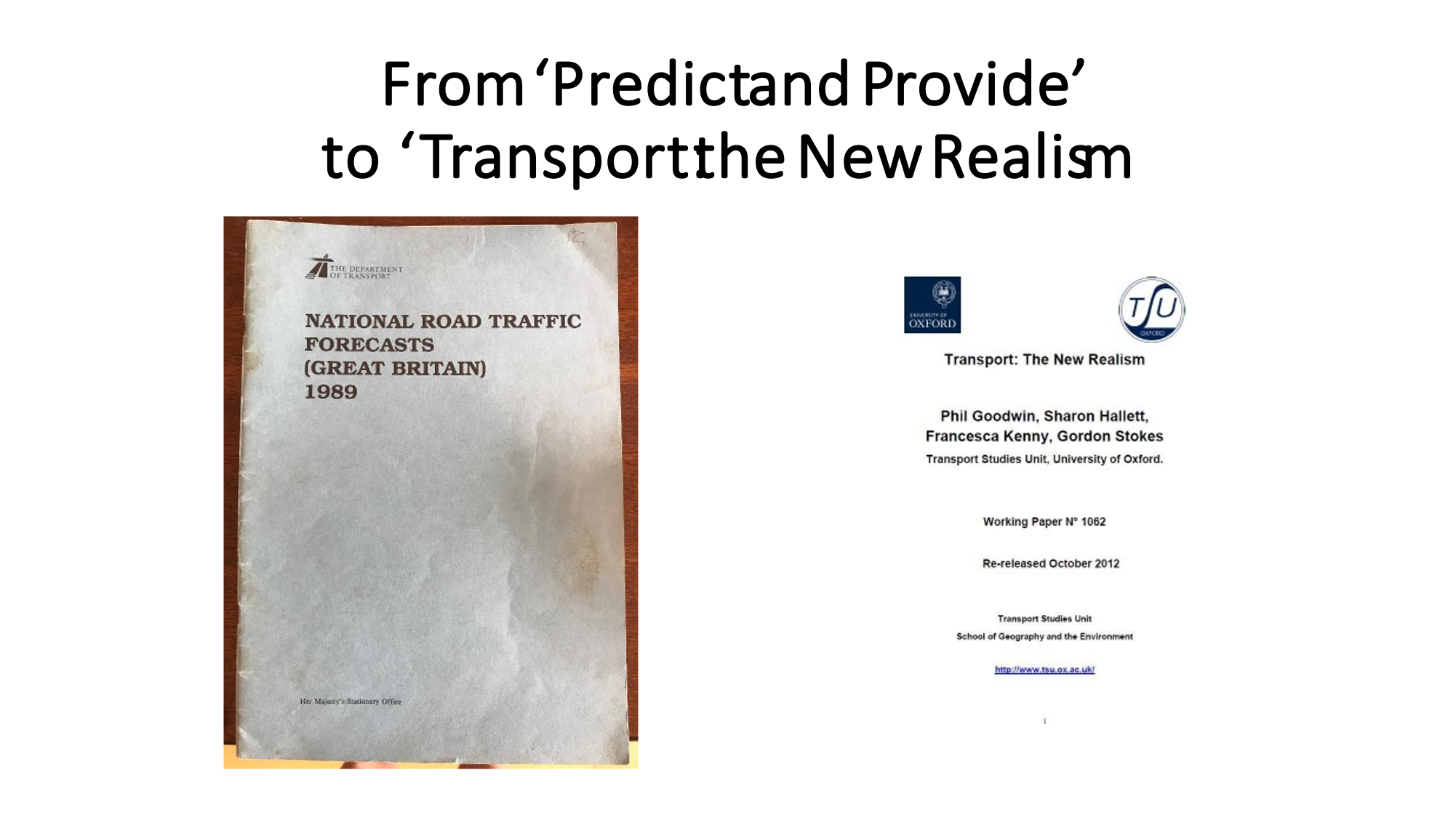
At the height of this discussion we bid for a remarkable initiative of the official Economic and Social Research Council, ESRC, part of their strategy at the time to support academic ‘Centres of Excellence’, later retitled ‘Designated Research Centres’, on themes which were devised by the applicants, not the ESRC itself. They awarded us an unprecedented ten year grant to carry out a research programme, which had two parts:
-
The issue of the inevitability of traffic growth would have to be reviewed. Demand management would have a much greater role, to reduce the dominance of car use. ‘Predict and provide’ would be replaced by ‘predict and prevent’. This required a research strategy which included observation in real time of what actually happened when new transport policies were implemented, as compared with their expectations and intentions, using deliberately multidisciplinary frameworks of engineering, psychology and sociology as well as economics.
-
And, we argued, the whole methodology of demand analysis and forecasting, which had been built very firmly on the basis of economic equilibrium, would have to be re-specified on a dynamic basis, which would allow for concepts such as path dependence, inertia, habit, partly non-reversible processes, and an explicit distinction between short and long run processes, with a knowable time scale linking the two. The data requirements would have to include explicit time series rather than (or in addition to) repeated cross sections, and especially longitudinal panel data sets, growing from our earlier interest as discussed above.
This programme for the newly designated ‘ESRC TSU’ was launched on 13th October 1994 at a big public lecture, part of a series on the Environment organised by Linacre College. This was a time when transport professionals were waiting for publication of the report of a committee inquiry which was to demonstrate that building roads generated additional traffic[6]. That committee had been chaired by Derek Wood, a lawyer and Principal of St Hugh’s, and I was another member, with lead responsibility for the chapters on assessing the empirical evidence. After discussion with DfT, I foreshadowed the induced traffic finding in the launching speech, and the BBC Today programme reported it that morning, as having the impact, ironically, of a runaway juggernaut. A few days later, on the 16th October the Observer reported ‘Tories Plan U-turn on car culture’, reversing decades of policy. (I’m not claiming credit for that, of course. It was more that our timing was precisely right).
Flushed with this success, in June TSU and the Environmental Change Unit held a joint one- day conference, including a ‘Great Debate on Transport and the Environment’ which filled the Sheldonian, with a visibly awed Secretary of State, among others, as speakers. That was all very exciting, And, to be honest, great fun. Just the right time for hubris.

The Sheldonian event turned out to be something of a swan song for TSU, for a while. due to some differences about how the ESRC funding would be spent and supported. The University, the ESRC, and University College London had prolonged discussions, and eventually we all agreed that the programme of work would be better delivered if TSU, now called the ESRC Transport Studies Unit, would move from Oxford to become a separately managed part of the much bigger (and rather older) Centre for Transport Studies at UCL, together with the money, and some other projects, and all the research staff. (There was some welcome flexibility, allowing for personal circumstances, about where they would sit as between Oxford and London).
Which is what happened in January 1996. The research and policy outcome of that programme of work’[7], and its impact on the Deputy Prime Minister, the 1998 Government Transport White Paper, and the following Acts of Parliament, became part of the UCL story, not the Oxford Story[8].
A New Oxford TSU
For a while, transport studies almost disappeared in Oxford, with the long-serving administrators, Sylvia Boyce and Ann Heath providing a bridge. There were questions about whether TSU would continue at all: but a new TSU had to be established as the CIT endowment was still producing income, and under the Statutes could not be spent on anything else, though that idea was mooted. Thus the CIT endowment, for the second time, secured the future of TSU. A competition was organised about who would be the host faculty for the new TSU, with three contenders: Social Studies (Economics); Engineering; and Geography. The School of Geography won, and built a strong link to St Anne’s College. Maybe it always should have been there.
New Directions: Young People’s Travel, and Climate Change
There have been two recent developments during Tim Schwanen’s direction which I would like to touch on.
The first of these was a project led by Kiron Chatterjee[9], a collaboration between TSU and the Centre for Transport and Society at the University of the West of England. (That’s where I went after UCL), It was a great opportunity to collaborate with Tim, and involved altogether 11 Researchers from Oxford and Bristol, including Gordon Stokes who had become the bridge between the old TSU and the new one.
The project stemmed from an observation in the early 2000s by the DfT Chief Statistician that young people seemed to be demonstrating less orientation to car use than their parents, and had been doing so, without anybody noticing, for a decade. We found that, since about 1991, each succeeding cohort of young adults learned to drive, bought cars, and used cars less than the previous one, at least up to about 2015 which was the limit of the data we had.
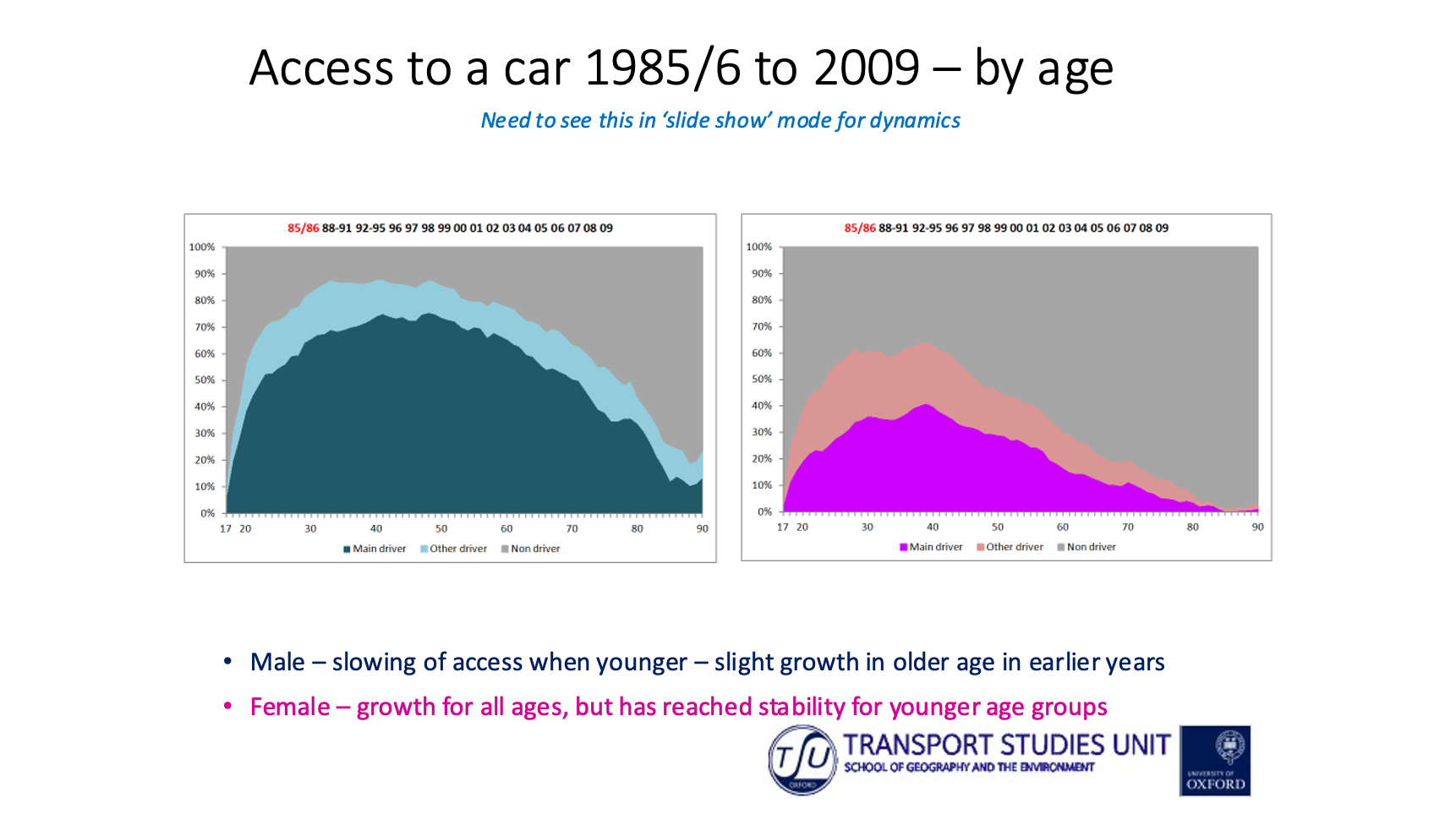
Even more important, this relative reduction was sustained, at least in part, as the young people became middle aged. Essentially, the overall growth in car traffic was slowing, and such growth as there was, was driven by older generations. We don’t know what happened since.
For a while it was welcomed with open arms by the DfT, with invited presentations to much wider groups of its staff than the sponsoring section, but that came to a halt, and now its only evident change in practice has been a footnote to one of the many traffic forecast scenarios published by the DfT, with a notably lower traffic forecast usually ignored in road appraisal. Nobody is talking about the potential long-term ramifications. Its time is still to come, and in my view this may be - or could have been – or might still become - the single most important research project that TSU has been involved in. It needs to be relaunched.
Climate Change
The other current strand I want to comment on has been transport and climate change, particularly Christian Brand’s work, much of it in collaboration with Jillian Anable from Leeds University, with whom I’ve also been working, with support from a Senior Fellowship supported by the Foundation for Integrated Transport[10].
Although the harmful effect of transport on climate change has been an explicit theme in national and international transport policy since the late 1980s (and had been foreshadowed in research by the coal and oil industries and others for a century), this knowledge had little influence on transport projects and strategy until much more recently. It has seemed as though changes in official advice in 2020 and 2021 were signs of a real sea-change, such that transport sustainability should – and could – genuinely contribute to reversing the direction of change in transport carbon production. In retrospect, I would now have to say (as others did at the time) that that assessment was over-optimistic.
Now, the environmental crisis has intensified, but its expression, a continuing series of weather crises of flooding, drought and heat, has had to fight for attention against other headlines: the Covid Crisis, the Economic Crisis, the Brexit Crisis, the Energy Crisis and the Cost of Living Crisis, all developing alongside an unprecedented intensity of a crisis of governance. At the same time there has been a breakdown of many long-established expectations of how the British political system should work, and a lack of clarity in its direction and priorities. Assumptions about the future economic and social influences on travel demands and needs, continue to rely on a completely implausible form of ‘Business as Usual’. Such movement as there had been in implemented policy, has been eroded.
The combination of these factors has given space for a ‘push-back’ at local, regional and national levels against the principles, methods and assumptions of sustainable transport.
The Committee on Climate Change has recognised this in its most recent report to Parliament, in June 2023, sobering reading for its critical assessment of the shortfall indelivering necessary policy and technical change, reporting in a month of unprecedented global environmental damage. In particular, it advised that the UK transport sector was failing to deliver essential demand reductions in the volume of ground and air traffic. It called for a fundamental review[11] of present and future road schemes, to avoid locking-in unsustainable patterns of behaviour.
A realistic appreciation of the pivotal importance of climate change, and transport’s position within that, is and surely should be part of the common currency of all the main University research groups. From that point of view TSU continues to pull its weight, and continues, like us all, to worry that our weight may not be enough.
References and Links:
-
Munby D (1968) Transport, Penguin Modern Economics, Penguin, 1968
-
Jones P, Dix M, Clarke M, & Heggie, I (1983) Understanding Travel Behaviour, Oxford Studies in Transport, Gower. This was the first of a series of eight TSU books we called ‘Oxford Studies in Transport’ series, all published by Gower/Avebury ,which became part of Elsevier.
-
In a review article in 1997 I summarised results from ten different TSU-organised panel surveys producing 27 papers by 18 different authors: David Armstrong, Kay Axhausen, John Bates, Peter Bonsall, Sue Carpenter, Mike Clarke, Martin Dix, Phil Goodwin, Peter Jones, Francesca Kenny, Ryuichi Kitamura, Henk Meurs, Shirley Meadowcroft, Laurie Pickup, Bill Tyson and Gordon Stokes. Goodwin P (1997) Have Panel surveys told us anything new?, in Golob T, Kitamura R, & Long, L, Panels for Transportation Planning: Methods and Applications, Kluwer Academic Publishers, Boston
-
From black and white to shades of grey – the flawed world of expert knowledge dissemination in transport https://tapas.network/32/goodwin.php
-
Goodwin P, Kenny F, Hallett S & Stokes, G (1991, reissued 2012) Transport: The New Realism, Oxford University Transport Studies Unit.
-
Standing Advisory Committee on Trunk Road Assessment (SACTRA) (1994) Trunk roads and the Generation of Traffic, Department of Transport, HMSO, available online at https://bettertransport.org.uk/wp-content/uploads/legacy-files/trunk-roads-traffic-report.pdf
-
The final report to the ESRC, including a bibliography of work done on the ESRC Transport Studies Unit programme, 1995-2004, both at Oxford and UCL, was Goodwin P, Cairns S, Dargay J, Hanly M, Parkhurst G, Stokes G and Vythoulkas P (2004) Changing Travel Behaviour, a title deliberately referring back to the TSU foundation work by Jones et al (1983).
-
In 1997 there was a General Election, producing a Labour Government with John Prescott as Deputy Prime Minister and Secretary of State for a merged Department of the Environment, Transport and the Regions. He appointed an external advisory committee to help write a new White Paper, which I chaired. The White Paper included much on demand management, referring back to the change in Conservative policy since 1994, and road building as a last priority. There was enabling legislation for road pricing, on which congestion charging in London was launched, though not in the 20 other cities envisaged. We were later twice commissioned to develop a system for dynamic forecasting of travel and emissions, neither of which were implemented, partly because of the policy disruption which might follow, it was thought, from having two different official traffic forecasts, and partly because resistance to change in modelling can just as powerful as to change in policy.
-
Chatterjee K, Goodwin P, Schwanen T, Clark B, Jain J, Melia S, Middleton J, Plyushteva A, Ricci M, Santos G, and Stokes G (2018) Young People’s Travel: What’s Changed and Why? Department for Transport, https://www.gov.uk/government/publications/young-peoples-travel-whats-changed-and-why
-
Goodwin P (2023) Transport and Climate Change Unresolved, Senior Fellowship Final Report, Foundation for Integrated Transport https://integratedtransport.org.uk/downloads/FIT-Senior-Fellowship-Report-Phil-Goodwin-July-2023.pdf
-
The CCC specifically advised that this review should be similar to that carried out by the Welsh Government, which is interesting as the review body was an independent panel working to a policy brief committed to traffic reduction.
Phil Goodwin was a visiting fellow at TSU in 1976, its Assistant Director in 1979, then Director and Reader in Transport Studies, and Professorial Fellow of Linacre College Oxford, until the end of 1995, when he and TSU decamped to continue its research programme at UCL until 2004